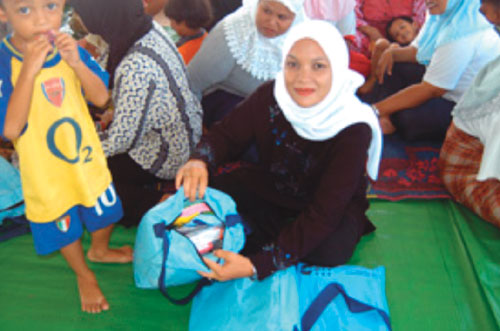Japan's Official Development Assistance White Paper 2005
Main Text > Part II ODA DISBURSEMENTS IN FISCAL YEAR 2004 > Chapter 2 Details and New Policies about Japan's ODA: Striving for Further ODA Reforms > Section 2. Measures for Each of the Priority Issues > 3. Addressing Global Issues > (3) Population
(3) Population

Hygiene kits made with the cooperation of UNFPA and Japan

Women receiving hygiene kits
The world population has doubled in the past 50 years, and reached 6.378 billion in 2004. 33 This is a global issue that affects other issues such as global environment, food and energy. The average annual population growth rate for 2004 was 1.2%. Meanwhile, among the developing countries, there continues to be a tendency for poor countries to have a higher population growth rate, significantly affecting poverty, unemployment, food shortage, unqualified education, and environmental deterioration in those countries; hence to address this issue is urgent. For example, the population growth rate in Burundi, which has a low GNI of US$610, was 3.1%, and in Somalia, Liberia, and Afghanistan the rates were 4.2%, 4.0%, and 3.9% respectively.
The population issue must be tackled from both sides of the micro-level including such issues as individual health and welfare programs, and the macro-level involving population increase and decrease. Japan has been providing assistance to developing countries not only in the area of reproductive health and family planning, but also in basic health care, education for girls and gender equality, which are indispensable to achieve the goals of the population issue. Moreover, in the population field, assistance via international organizations is particularly effective, utilizing specialized knowledge and networks. In FY2004, Japan provided assistance of ¥4.4 billion to the United Nations Population Fund ( UNFPA ) and ¥1.7 billion to the International Planned Parenthood Federation ( IPPF ). These organizations provide support for improving the health of pregnant and nursing women and for promoting maternal and child health, as well as collecting and analyzing population-related data such as the census of developing countries, enhancing women's capabilities, and educating and advocating adolescents reportedly accounting for over 1.2 billion of the world population.
In FY2004, Japanese NGOs implemented the following projects; education of the public on reproductive health in Myanmar, enhancement of education programs on reproductive health for adolescents in Latin America and the Caribbean, and STI (sexually transmitted infections) and HIV prevention for construction workers and the local community involved in the construction of the Second International Mekong Bridge across the Mekong River on the border between Thailand and Laos.
As for the Collaboration with UNFPA, the UNFPA campaign to end fistula, Japan assisted "Enhancing Capability for the Prevention and Treatment of Obstetric Fistula," which was implemented through the Trust Fund for Human Security in Nigeria, Pakistan, and Mali. This project aims to help women who suffer from obstetric fistula, caused by prolonged 34 or obstructed labor that is widely found in sub-Saharan Africa, South Asia, and some Arab countries. It is expected to promote the prevention and treatment of obstetric fistula and help establish safe delivery procedures.
2004 marked the tenth anniversary of the International Conference on Population and Development ( ICPD ), held in Cairo. Japan, as a member of the United Nations Commission on Population and Development as well as the Executive Board of the UNFPA, intends to promote the implementation of Programme of Action adopted at the ICPD and international efforts to achieve the MDGs, and to actively participate in discussions regarding population and development, reproductive health, and gender equality.


 Next Page
Next Page